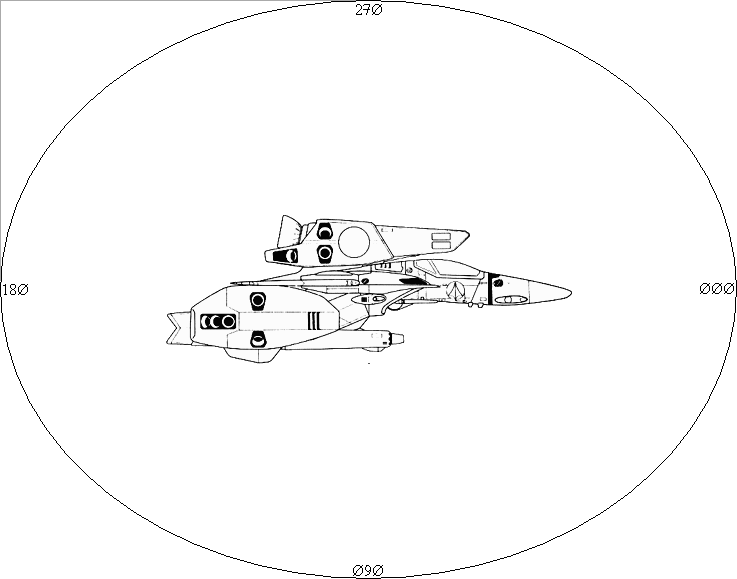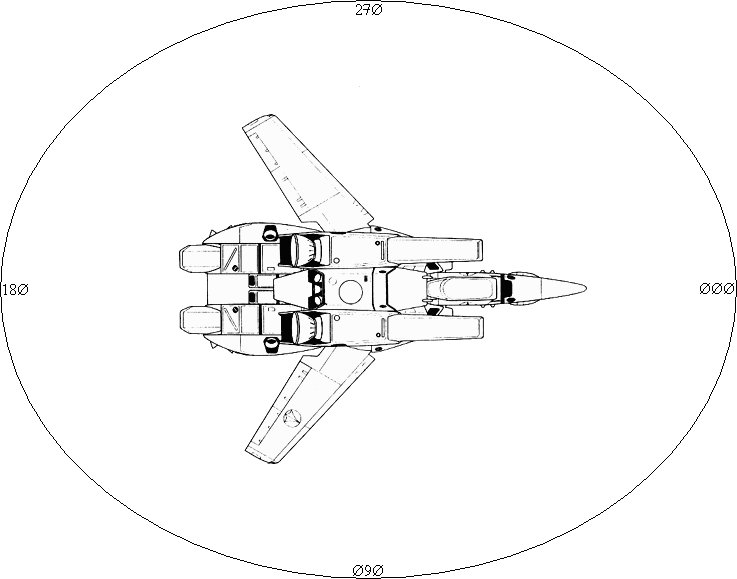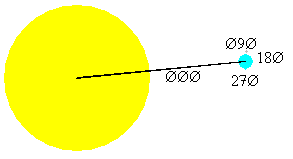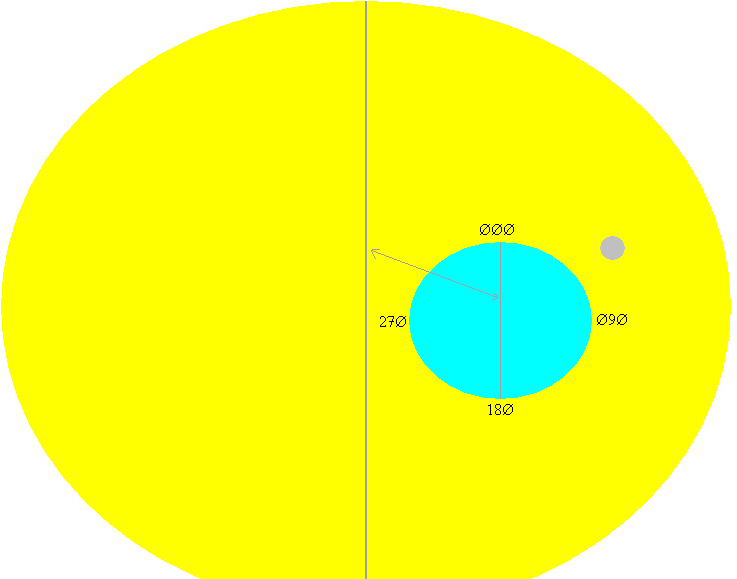 | Lt Col Andering "Andy" REDDSON, REF/BOS | 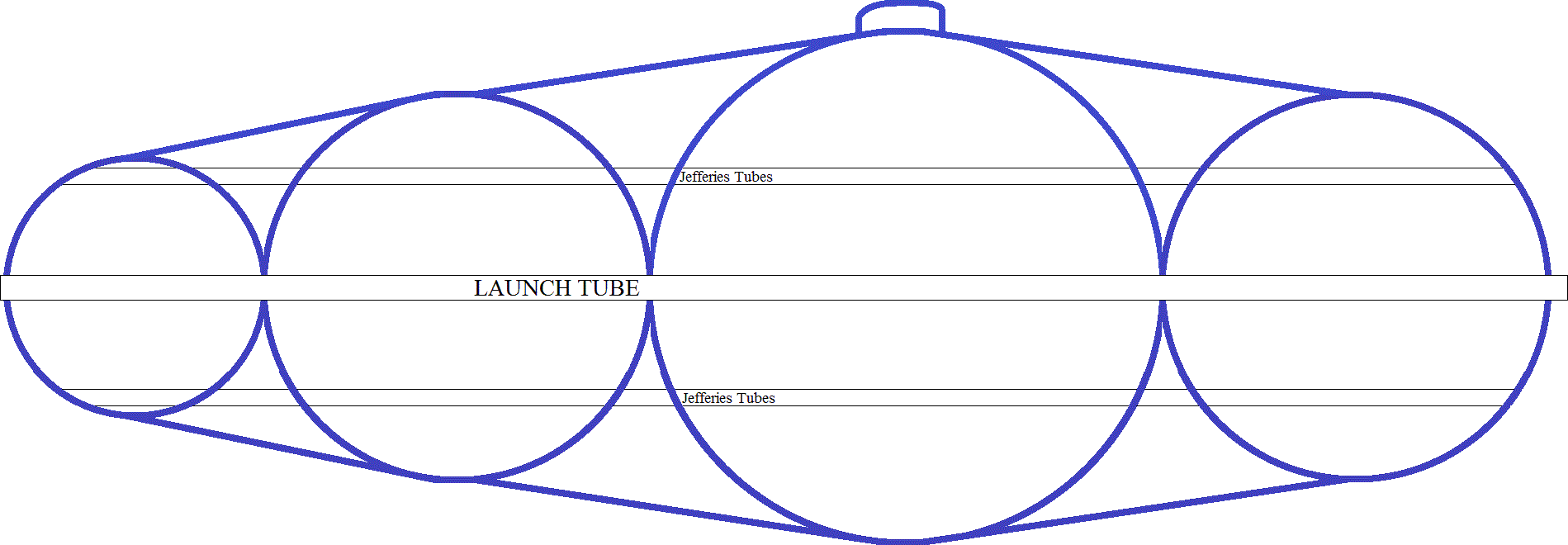 | |||||||||||
|---|---|---|---|---|---|---|---|---|---|---|---|---|---|
| Much speculation in sciences fiction has taken place on the nature of spaceships in terms of form and function. In this essay, I will attempt to help whittle down some of the mistaken concepts and rebuild them with science-based theories; However, keeping mind that eventually these are only theories, and can not be proven until such vsls are actually built. The most efficient shape for a ship is the sphere; It maximizes internal space while minimizing surface area (the outer hull). However, as vsls grow in size and scope, the spheres become larger until eventually they become untenable. It is at this point, then, that one considers stretching the sphere, creating a cigar, or submarine, shape. The long, rounded tubular design most efficiently lends itself to the design of starships; Even with the spherical doctrine, one need only join a series of spheres together, then overlay them a false hull to achieve the submarine shape. To join these chains, or for a purpose-designed cigar shape, a central core, varying from a simple 1/2" rod to a tube up to and including several hundred feet across (internal diameter) would provide the "keel" AROUND (rather than above) which the rest of the vsl would be built. Whether the ship is assembled on a deck by deck basis, or whether large discus-like bulkhead are installed then the hull segments around or between these is still speculative, however I will speculated that the bulkheads would be assembled, then the hull sections built between them. Also, while the 1/2" rod is possible, I submit that the keel would more likely be between 2.5' and 4' to allow access in even the smallest examples; Therefore I refer to them as "Jeffery's Tubes," due to their compact nature and the manner in which they are intended for use, to whit simple access to ships sections. How they would be outfitted would vary greatly, based on overall mission; For cargo vsls, a simple, oversized hold would generally suffice, by the simple expedient (in the chain sphere design) of removing hull sections of two or more spheres along one side or another where they could be loaded; Not more than 10% need be removed to load up the largest current containers in service (and this percentage DECREASES as hold size increases). Around the insides of each hold, grates providing a stable platform for the containers to attach to would prevent the movement of the cargo during transport. Aft of the holds, engines and control areas (the bridge) would be assembled just as now, with an access tube of some sort leading forward to permit crew members to check forward areas for damage, etc. Aft holds would be kept pressurized for cargoes that require it, though on the lowest safe setting for the cargo necessary, while forward more sections would be kept at lower pressure setting until the cargo reaches a point where no atmosphere is necessary (machinery equipment being shipped to another planet or system for example will not be harmed in any substantial way by exposure to hard vacuum, and may in fact be helped by the lack of air for oxidization). The green lines indicate accessways between holds other than the main Jeffrey's Tube, and may or may NOT be large enough for a person to fit through. The number in each section refers to the atmosphere in %. The letters denote purpose (primary purpose in BOLD, secondary purpose in italics if any). As the number of holds increases, the variety of pressures and cargo types increases as well; In the above list, "Fuels" are listed as "Flammable pressure sensitive cargos less susceptible to atmospheric loss"; This only considers known fuel types, and may not necessarily be correct at that. In the event that a hull section is damaged, it can simply be closed off; If it can not be, then the next section aft could be, until inevitably the crew is forced to don spacesuits and possibly abandon ship (not a preference to any sailor); As such, every crewmwmber "should" wear a spacesuit at all times, however this will be a practical impossibility. Perhaps someday we will be able to develop a ship's crew uniform that will be capable of serving as an emergency exposure suit long enough to don a proper space suit (this is what the Starfleet uniform of the 24th Century according to some Star Trek:TNG refrence materials). Time will tell. To load and unload cargos not sensitive to movement (basically everything except live animals), the whole hold could be spun, ala the center section of the fictional spaceship Discovery from 2001. This would allow cargos to be loaded and unloaded as necessary, without the need to move them about during the trip; If a certain cargo is going to one destination, then put it in one particular line, and as more cargos are picked up later headed to the same place, simply spin the hold to load them in. Once you reach that destination, spin the hold to put off that cargo, then take on new cargos from that location, spinning the hold as necessary. Example: Let us create four fictitious planets, named for real cities on Terra. One is Los Angeles, one is Tokyo, another Beijing, and finally Vancouver. Our ship, Ship 1, takes on her first cargo at Los Angeles- Seven containers headed to Tokyo, four to Beijing, and eight to Vancouver. At Tokyo, the seven containers to be put off there are rotated around (spinning only the holds, not the ship) and extracted, and new cargo is put on; Two to Beijing, five to Vancouver, and ten to Los Angeles. At Beijing, the six containers currently on board are removed, and the holds are rotated to bring on the Vancouver containers (three), then rotated again to bring on the Los Angeles container (one), then again for the Beijing containers (five). So the process is repeated; Never is the ship required to remove any cargo from the ship or even move it about on-board in order to offload other containers. Though it may seem redundant or even archaic, some form of superstructure will continue to be an element in the hull design; Though likely to be limited in scope, the superstructure nevertheless provides a critical function, and the pilothouse/bridge, chartroom, and very likely the Cabin will be found in this area. Militry Vsls: Militry vsls would vary from civilian vsls in no substantial way in the general manner of construction, with the possibility of a few noteworthy exceptions, but would DRASTICALLY vary in the manner of layout and arrangement. While the diagram above would be more than sufficient to understand the base principles of layout, some DRASTIC changes occur beyond the simple hull engineering. First and foremost would be the presence of weapons; Lots of them. Assuming that the lasers of science fiction are ever developed, rather than the relatively weak and puny toys we currently have available, we can safely assume that these would present the bulk of the vsls weaps. The reason for this is "expendability"; Even the mightiest of warships can only carry so much mat'eri'el, and the more foodstuffs, fuels, and etc. they carry the longer they can stay out. By limiting the number of missiles, more space becomes available for those other mat'eri'els. However, assuming those lasers do not become available, long-range missiles, such as the Trident and her various counterparts, would likely make up the bulk of the ships weapons. The exterior hull would likely have one VERY significant difference from a civilian vsl; Wings. Not the long, graceful things of fixed-wing aircraft, but the short, stubby affairs seen on rotorwing craft. Observe Diagram #02, "Hull Profile, Topside, Warship"; You will note two equally legitimate and somewhat directly competitry theories on the form these wings would take. Concept One presents the idea of smaller wings, and possibly several of them. This concept would limit the damage done should the wing be ripped away or otherwise damaged to a smaller area of hull. Concept Two, a hull-length or nearly so single wing, would spread the damage done to either wing to a greater area, lessening the immediate effect. Which concept is better is a question that can only be determined upon trial and error. Traditional warship doctrine holds that two ships would move into a general area and begin slugging it out at range, maneuvering relatively little over the long-term for advantage; Air combat holds that two planes maneuver greatly, each trying to get on the other's "6 o'clock" position to destroy the engines. The inevitable melding of these two diametrically opposite theories is the circling of the two ships, like animals in a fight; Each is trying to get themselves into position to strike the other's stern, where the engines and much of the thrust would be located, while not exposing their own drives. Adding to this is the very likely broadside fighting that both vsls would engage in. This will inevitably cause damage to the hull, and the wise ship's captain would spin his hull to lessen the effect of any given blow. This then leads to what I refer to as "Pattern Delta," or the continuing spiral and inwards approach, which would look from above or below for all the world like a Doughnut (a type of splicing). As the battle progressed, either one vsl or the other gets the position necessary to inflict maximized damage (namely a clear shot at the enemy's stern, damaging the drives and consequently effectively killing the ship), or the hull itself becomes too badly damaged to continue fighting and the skipper is obliged to withdraw to save his/her ship. In the movies, however, we see two ships, generally static to one another, slugging it out with their forward batteries; I think it highly unlikely the two ships would remain static for long, but a forward battery of ultra-heavy weaps, in a fixed fire position, would not be terribly unlikely, with the desire being to inflict heavy damage upon the enemy before the doughnut even begins, and thereby hopefully take them out of commission at the outset. Another aspect, often overlooked by science fiction writers, is the so-called "Battle Carrier" concept; All that is necessary for an aircraft carrier to be effective is the fairly simplistic ability to launch and recover aircraft. In this consideration, the aforementioned Jeffery's Tubes of civilians ships could be greatly widened, to the extent that that could be the very launch tube. I refer to these as "Rail Tubes," as a series of electromagnets are used to pull the fighters along in the forward for launch, thus saving fuel for the battle ahead, and latter are re-used to pull the fighter BOB. Arrestor hooks may or may not then be necessary to stop them once inside. Though this flies in the face of current carrier deck dogma, that is the "Angle Deck" concept which allows a craft to be launched as another is recovered, it remains nonetheless the most logical layout for the carriers of space. Furthermore, EVERY ship could carry at least a few small craft for scouting and harassment, if not as the main power projection system. The carriers of the fleet would simply carry a whole lot MORE of them. Additionally, located around the hull could be staples, simply metal rods bent around in a specific design, allowing a fighter's arrestor hook to catch the hull of the ship, either for permanent retraction (to pull the fighter back in), which is unlikely, or for temporary holding (and possibly re-fueling) while awaiting their turn to RTB. (Priority, of course, would go to certain considerations; Most likely, those with atmosphere loss, then medical problems, then disabled craft, and then low-fuel craft.) An often repeated comment on fighter craft in space warfare is the "morality" of putting fighters into space at all; This is hogwash, as proven time and again when "puny little fighters" defeated even the highest and mightiest of warships (reference MOST glaringly the Japanese near total annihilation of the US Navy's Pacific Fleet and the US Army's Pacific Bases in WWII, and all this IN ONE DAY). No, the TRULY immoral idea is to put 2,000+/- people on one ship and pray they don't all get taken out at once by a lucky shot. However, SOMETHING has to ferry the fighters into combat, then service and fuel them afterwards, and this something will inevitably be the warships. What form or theory eventually prevails in fighter craft design is still too far remote to say, though it will likely be recognizable even the Wilber and Oroville WRIGHT (if only later in life). | |||||||||||||
General Navigation
Navigation in space is based on three sets of data: 1. Relative Bearing; 2. Angle Bearing; and 3. Range. The Relative Bearing is the bearing, clockwise, from the bow of your own vsl all the way around to the stern, and back forward again. For example, an object directly to your own right is at 0900. The Angle Bearing is the bearing from your bow, working down to directly below, back up again to directly aft continuing to directly above, and back down again to directly in front again. For example, an object directly below your own sip would be, again, at 090 degrees. The third data, range, is how far away the object is from your own position. This is said in miles, unless otherwise stated in advance (ie, if you intend to say 100 feet, you will have to specify "feet"). Example Situation: Regults are approaching the SDF-1 on her port quarter, low, currently at 1,000 miles. The position, therefore, is two two three MARK (or X) two one zero mark 1 thou-sand. This expresses an angle of 223 mark 210 mark 1,000; You do not need to say degrees nor miles over the coms net. This data also is required when plotting one's own direction, with the exception of FTL drives (see below). To travel from, say, Terra to Jove, you must plot the direction from Terra's current position (or her position once you get there) to Jove. Assume that Jove is in her Antlliery position, with Terra entering January; This will put Jove well behind Terra. You would then swing around Terra to pretty close to her dusk line, then plot approximately 338 mark 012 mark several million miles. Keep in mind that this course must reflect not only Joves current position, but her position where she will be in time, like leading a target. Planetary Navigation Orbiting a planet is a deceptively complex set of assessments; First, calculate the planetary bearing. The planet's bearing is from the planet's pole to the star's pole; For moons and space stations, the bearing is from the moon or space station to the planet. The 0000 bearing is directly from the planet's pole to the star's pole. You work around the planet to the right all the way around, both horizontally and vertically. Therefore, to transit from, say, Moscow to Antarctica, when Moscow's local time is dead midnight, and to transit into daylight before reaching the south pole, one would plot a course of 0000 by distance necessary; The distance will vary based on distance from the surface, and in this orbital transit will have a third set of numbers: Distance to surface. This, too, is expressed in miles, and most civilian vsls run at about 100-150 miles over the surface. Militry vsls on routine cruise will generally stay higher, but may well go lower (often unexpectedly and unannounced). All courses are based on these measurements, but as a general rule, traffic patterns go clockwise, approaching vsls entering at the sunset (west) side, swinging around to the sunrise (east) side, staying in the sun; They will stay in orbit at a designated height unless directed otherwise. Therefore, a ship would "enter" orbit at about 270 and "exit" at 090 in Chart #4, Orbital Bearing Chart/horizontal configuration. Note Chart #3, Orbital Bearing Chart/vertical configuration (click on the image itself to enlarge). You will observe three circles; The large circle is the local star, the medium circle the planet, the small one a satellite of the planet (presumably a moon). To transit from the planet to the moon, assuming you are along the equator at the side you observe now (this would put you at apx 000 mark 170 mark a couple hundred), you would set a course currently of apx 045 mark XXX (see below) mark Height over planet (typically apx 60+/- miles) by Distance to the moon at intended orbit (say 20 miles). Assuming you are transiting the planet along the standard traffic pattern, you would come around approximately 135 degrees, then maintain distance, level off relative to the planet, then engage thrusters at the angle necessary to achieve moon orbit; Assuming the moon is directly in front of you, the variable 'XXX' above would be 000. However, typically the target will be slightly down or up; In the case of a down-angle, maintain your height until the target gets into proper alignment, then set a 000 course. In the case of an up-angle, you will come to the new course immediately, or on the next pass, circling the planet. Trans-Stellar Movement Movement from one star system to another is actually quite a bit simpler that trans-planetry movement; One simply transits from the edge of the system they are in, determine any and all obstructions (gravity wells), and simply tells the computer what courses to plot; Spacefold doesn't even require that much. Keep in mind, though, that the computer will still need to know the first two sets of information, Bearing and Angle. Distance is helpful, when one knows the distance they are going (not always possible, in cases of exploration for it's own sake, though still required for spacefold; shorter jumps can offset this problem), then engage FTL/Spacefolds. The computer will do the rest. Trans-Galactic Transiting Trans-galactic transit is just a long-distance version of trans-stellar movement, with one significant exception; It must be done with Spacefold, as other FTL technology simply can not reach far enough to be practical. (They could do it, but it would take about 250+/- years to go just from Milky Way to Andromeda, and the two's gravity wells are now close enough to create navigational hazard to FTL drives.) However, special transiting rules apply to trans-galactic movement; One must enter and exit at designated waypoints into the galaxy. Entry at other than authorized waypoints is considered a criminal offense in and of itself, and is grounds to inspect on suspicion of smuggling. A vsl engaged in such activity may be fired upon with neither notice nor provocation.Transiting between galaxies is highly complex calculations, but are generally based on positioning the ship in a location above or below (zenith or nadir) the galaxy's center point where the gravitational effects no longer influence the ship's spacefold system (how far out this is will be partially influenced by the size of the spacefold envelope, the bigger the envelope the further out it must be), generally 5 times the size of the diameter of the black hole at the galaxy's core. A spacefold can be executed close to the gravity wells, but the further out from them it is the safer the operation is. Multiple Point Coordination (Multi-Pointing) When two or more vsls or groups are working together, each shall relay according to their OWN relative and angle bearing; Going back to our Regults attack on the SDF-1, the ships' bridge would detect the attack; Once it crosses the yellow line, the bridge controller would then task a Veritech group of sufficient size to intercept them. The bridge controller would report to the Veritech group leader the Regult's position relative to the SDF-1, not to the group's position; The Controller can not necessarily know what the group is doing. The group leader would then calculate what his course and distance is to the ship, then calculate the difference. This is part of why groups were given very specific patrol areas- Simplifying the math. Special Instructions While course information is said as "mark" to avoid confusion, it is written with the times sign (X). Do not use the period or decimal symbol; You may actually use this symbol (example, 135.25 to express one three five decimal two five degrees). Saying and writing "degrees" is not necessary and will only lead to unnecessary confusion. Remember to read out numeral individually, one, two, three, etc., not collectively, one hundred twenty three. Especially when rushed, or over comms nets, "thirteen" and "thirty" sound too much alike; Combine the two, and you're guaranteed to have a problem. | |||||||||||||
Cartography is the study and practice of making navigational charts; It builds on the premise that reality can be modeled in written and pictographical form in ways that communicate spatial information effectively. Much has changed
General Cartography Cartography is establishing a "point a" relative to a "point b" over distances. A unified cartography model was established under the Intergalactic Council On Planetry Bodies, Council Committee On Sciences (2582) using 2 universally established benchmarks that can be isolated in every galaxy and star system. Galactic Cartography To determine a galactic chart's starting points, and therefore the position of stars, planets, etc., choose two points. First draw a big circle around the entire galaxy. Within this circle, select the absolute galactic center. This is your first reference point, Zero mark Zero mark Zero. The second is the furthest detectable object in that galaxy. A line between these two points is the 0000 line. Everything is relative to this line; The reciprocal line is the 1800 line. from there, count out the standard 3600 marks around the circumference of the galaxy. Most galaxies now have a navigational beacon that shows the local 0000 line, using the aforementioned furthest detectable object at the time of the survey. Stellar Cartography Stellar cartography uses the same model for charting the local galaxy; Select the center of the local star, then the center of the host galaxy; This is the local 00 line for that system. Around these lines, count out the typical 3600 marks. Planetry Cartography Charting the stellar bodies around the star uses the same model but at smaller scale; The star's centerpoint is plotted to the body's centerpoint making the 0000 point. Many planets with indigenous intelligent life have an established 0000 line, however in stellar cartography it matters only what the solar/body relative line is. Once you have entered into orbit above the body you will switch to the local preferred cartographical model. Inter Galactic Cartography Charting galaxies is only a measure of galaxies relative to one another; The relative angle of the galaxies to each other's zenith and nadir points and the relative angle of the galactic planes at the centerpoint is the only way possible to chart out whole galaxies. However, the UGC keeps a continuously updating chart of the galaxies as soon as they can be initially surveyed (before they are charted internally). | |||||||||||||
| A "tripline" is a somewhat-imaginary line the defines when hostile action is imminent; It is based specifically upon the abilities of the platforms in question (yours AND theirs). Example: A T'sentraedi Gulag (Officer Battle Pod) had all the weaps of a Regult, plus about a half-dozen or so missiles. These missiles have an absolute range of approximately 10 miles, but at effectively no reliability to connect with target; Even if they did, what little damage such an attack would have is highly doubtful. On the other extreme, we have, say, a T'sentraedi TOU REDIR-Class. Her weapons systems have exceptionally greater range, at nearly 10 with 90% power-to-target. This places her orange line (see below) well beyond the Gulag's black zone. These zones must be considered against four sets of computations: 1. Nature Of Weapons: What kind of range and power-to-target does it have. How far back do I have to stay to make this a non-threat? 2. Numbers: How many of them there are. While an individual Gulag is pretty much a non-threat until the last hundred yards or so, a full battalion of them, by shear number of missiles etc., will likely hit something from a much greater distance. 3. Relative course and speed: Is it inbound, outbound, moving slowly or quickly, or is it going around in circles? While a NUPETIET-VERGNITZS-Class Flagship is a threat at nearly any range, if it's just sitting still in my yellow zone, I probably can risk ignoring it for the time being; However, the QUEL QUALIE-Class Recon Scout that keeps rushing from one side to the other of the green zone, crossing into the yellow, and back again is a threat. Blow her away. 4. Own ship capabilities: As discussed above, an individual Gulag is pretty much a non-threat until the last hundred yards or so. However, the weapons systems of an SDF may not be able to engage the target, or at least not as effectively. It serves no purpose to ignore a threat just because it's "too far away," if the threat range is withing my own blast radius. An example of the most perplexing calculation, number 4, is best shown by the SDF-1's handling of the QUEL QUALIE-Class piloted by Rico, Bron, and Konda. Their ship's weapons were more than able to engage fighters, Destroids, and etc.; However, the main weapons batteries of the SDF-1 could not reliably engage within 5 miles, without risk either to the SDF-1 herself, or in most cases at all. Enemy in this area can not be targeted, therefore, by the ship's own weapons, and must be dealt with by alterative means; To this end, Destroids were deployed on the hull of the ship, but this option was inadequate, as Destroids really weren't meant for that type of fighting. The "zones" are divided up into 5 parts: The Blue Zone: Too far away to be considered any kind of threat. This usually means they are on the edge of the system, behind a large obstruction of some sort (such as a planet), or otherwise unable to engage. It should be noted that simply existing makes all enemies, at best, in the blue zone- Even on the far side of the universe. The Green Zone: While the enemy is closing the distance, only the most extreme range weapons can actually be brought to bear; Additionally, these are either insufficiently reliable (either to do damage or to actually connect), or can be dealt with at least a 90% probability of defeat (ie anti-missile defenses are more likely to destroy missiles than the missiles are to find their target). The Amber Zone: A significant risk of threat has arisen; A majority of the enemies weaps can be brought to bear, even if most 'could' be mitigated. The target should be watched warily, with changes in bearing and distance noted carefully. A target showing a propensity to close the range should be highlighted continuously, and any target in this range given routine warning shots, or a new course plotted to avoid contact. The Red Zone: The enemy is now close enough to engage, reliably, with all of their weapons systems. The only reason such an event should be allowed is if you specifically want them to, such as the "Daedalus Maneuver." The Black Zone: At this range, the enemy is too close to bring your own weaps to bear; This is a knife fight. Example include KYHRON and MIRYIA'S raids on the SDF-1, the Tiresian's crash into Monument City, and suicide attacks. The "Lines": There are two lines of importance; The "Orange Line", wherein a given target is partly in the Amber Zone, and partly in the Red Zone, and the Black Line, also called the "Line of Death", the closest your own weapons can get before they can not engage. For missiles, this is either the blast radius or minimum engagement distance, whichever is closer- Usually the two are the same. For lasers, this usually is about 100' (as the turrets can not angle down any further than that). | |||||||||||||
BOB: In capitals, it means "Back On Board." Bulkhead: Any partition that reaches from topside to underside, or from bow to stern. Cabin: The Captain's private space. Contrary to the common misconception, there is ONLY ONE cabin on a ship, and that is the captains. There may be one man staterooms, typically the XO/First Mate's, two man staterooms (generally officers), and four man staterooms (Junior Officers and Senior Enlisted Personnel), BUT ONLY ONE CABIN. Some may be as mall as a walk-in closet, others small to medium apartments (one I remember distinctly had a small berthing compartment with an oversized locker, a small office, a smaller dining area, and a PRIVATE head with shower; This one only qualified as a "small" apartment). Conduit: Any tube too small to fit in. Deck: What you walk on. Door: Any square access way through a bulkhead or partition that does NOT go through the hull: You have them in your home. Hatch: Any door through the hull, regardless shape, size, or nature. Jeffery's Tubes: Appearances aside, any service tube too small to be used as a general passageway, regardless how long or extensive it may be. Overhead: The thing above you. Partition: Anything that looks like a wall other than a bulkhead. Passageway: Any tube intended for crew to reach point A to point B without having to lay flat or otherwise contorting themselves. RTB: Return To Base. Scuttle: Any round doorway. Vsl: Vessel. | |||||||||||||

